全文HTML
--> --> -->压电材料的工作温度常被限制在其居里温度的一半以下. 长期以来, 特种高温压电器件 (≥ 400 ℃)不得不使用生产工艺复杂、成本昂贵的压电单晶材料, 但是高温压电单晶的压电性能十分有限, 而且压电晶体在抗冲击和振动方面远不如压电陶瓷材料[1]. 因此, 开发具有优异压电性能的高居里温度压电陶瓷材料已成为当务之急[2]. 目前研究的高温压电陶瓷主要有钙钛矿型(BiScO3-PbTiO3)高温压电陶瓷[3], 钨青铜结构压电陶瓷[4]和铋层状结构压电陶瓷[5—7]. 其中铋层状结构氧化物压电陶瓷具有居里温度高、自发极化强、电阻率高、老化率低、谐振频率的时间和温度稳定性好、机械品质因数高和易烧结的特点, 在高温高频领域具有广泛的应用前景, 是铁电压电材料研究的重点和热点之一[5—7].
铋层状结构氧化物由Aurivillius在1949年首次合成[8], 其有趣的层状结构和较高的居里温度引起了科研工作者的广泛关注. 从结构上讲, 铋层状结构氧化物是由含铋的(Bi2O2)2+层和ABO3结构的类钙钛矿层沿铋层状结构氧化物的c轴方向有规律地相互交替排列而成, 其化学通式为(Bi2O2)2+(Am–1BmO3m+1)2-, 其中A代表Ca2+, Sr2+, Ba2+, Bi3+, La3+等适合于12配位的+1, +2, +3价离子或由它们组成的复合离子, B代表Fe3+, Ti4+, Nb5+等适合于八面体配位的离子或由它们组成的复合离子, m为整数, 对应 (Bi2O2)2+层之间的类钙钛矿层 (Am–1BmO3m+1)2-内的八面体层数, 其值一般为1—5. 通过对比常见的铋层状结构氧化物的居里温度(TC)和压电性能(d33)[1], 可以发现目前见于报道的居里温度TC~900 ℃ (工作温度T ≥ 400 ℃)且具有较高压电性能的铋层状结构氧化物, 只有m = 2 铋层状结构铌酸盐, 且其原型化合物的压电系数d33一般不高于5 pC/N, 如CaBi2Nb2O9 (TC~940 ℃, d33~5 pC/N)[9]和Bi3TiNbO9 (TC~914 ℃, d33~3 pC/N)[10]. 然而, 与铋层状结构铌酸盐相对应的高居里温度m = 2的铋层状结构钽酸盐及其压电性能研究却鲜见报道.
Bi3TiTaO9 (BTT)为m = 2的铋层状结构钽酸盐, 具有较高的居里温度(TC~890 ℃)[11]. 图1为m = 2铋层状结构氧化物的晶体结构示意图, 可以看到, m = 2的铋层状结构氧化物是由含铋的(Bi2O2)2+层和含2个ABO3结构的类钙钛矿层沿铋层状结构氧化物的c轴方向有规律地相互交替排列而成. 前人对Bi3TiTaO9铁电特性有少许研究[12—14], 但对其压电特性的研究很少[15—17]. 近期, 科研工作者通过放电等离子烧结技术制备了织构化的Bi3TiTaO9陶瓷, 其压电系数d33 (⊥)~8.6 pC/N, d33 (∥)~1.4 pC/N[17]. 经过织构化的BTT陶瓷, 在性能方面具有很强的各向异性, 压电性能在特定方向(⊥)得到较大程度的提高. 但是放电等离子烧结技术仅用于实验室研究用, 研究成本甚为昂贵, 因此本文通过组分调控, 进一步提高BTT陶瓷的压电性能. 在本文中, 我们选取铋层状结构Bi3TiTaO9作为研究对象, 通过稀土Ce离子取代A位Bi离子, 提高BTT的压电性能. 选择稀土Ce离子来优化Bi3TiTaO9的压电性能是因为Ce离子经常用来提高钙钛矿结构压电陶瓷和铋层状结构压电陶瓷的压电特性[18—21]. 研究结果表明: 在x = 0.6组分处, BTT-6Ce (x = 0.6)陶瓷具有最大的压电系数d33 = 16.2 pC/N, 约为纯的BTT陶瓷压电系数(d33~4.2 pC/N)的4倍, 且居里温度TC为879 ℃. 同时本文还研究了BTT陶瓷的介电、铁电特性.
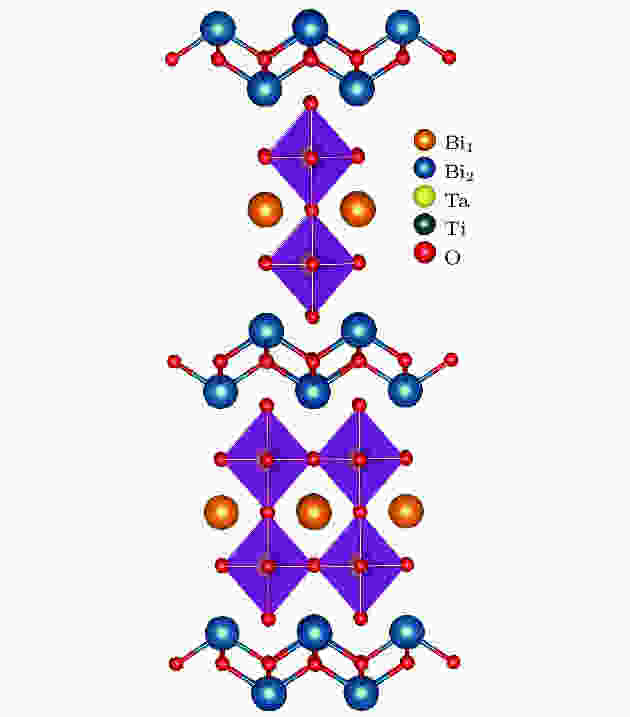 图 1 铋层状结构氧化物 (m = 2)的晶体结构示意图
图 1 铋层状结构氧化物 (m = 2)的晶体结构示意图Figure1. Crystal structure schematic diagram of bismuth layer-structured oxides (m = 2)
高温烧结后的样品质量密度由阿基米德法测出, 样品结构用X射线衍射(XRD)方法确定. 为测量样品的压电和铁电特性, 将样品研磨抛光至0.4 mm, 然后在样品的两表面用丝网印刷的方式被覆银电极, 并在600 ℃保温30 min处理. 被银后的样品在180 ℃的硅油中施加10 kV·mm–1的直流电场极化30 min. 极化后样品的压电系数d33由中国科学院声学所生产的ZJ-2型准静态d33测量仪测得. 样品的铁电特性利用TF Analyzer 2000E铁电分析仪测得. 为测量样品的介电温谱, 将样品研磨抛光至0.8 mm, 在样品的两表面用丝网印刷的方式被覆铂电极, 并在800 ℃保温15 min处理. 被覆铂电极的样品的介电温谱利用Keysight E4991A高频阻抗分析仪测得.
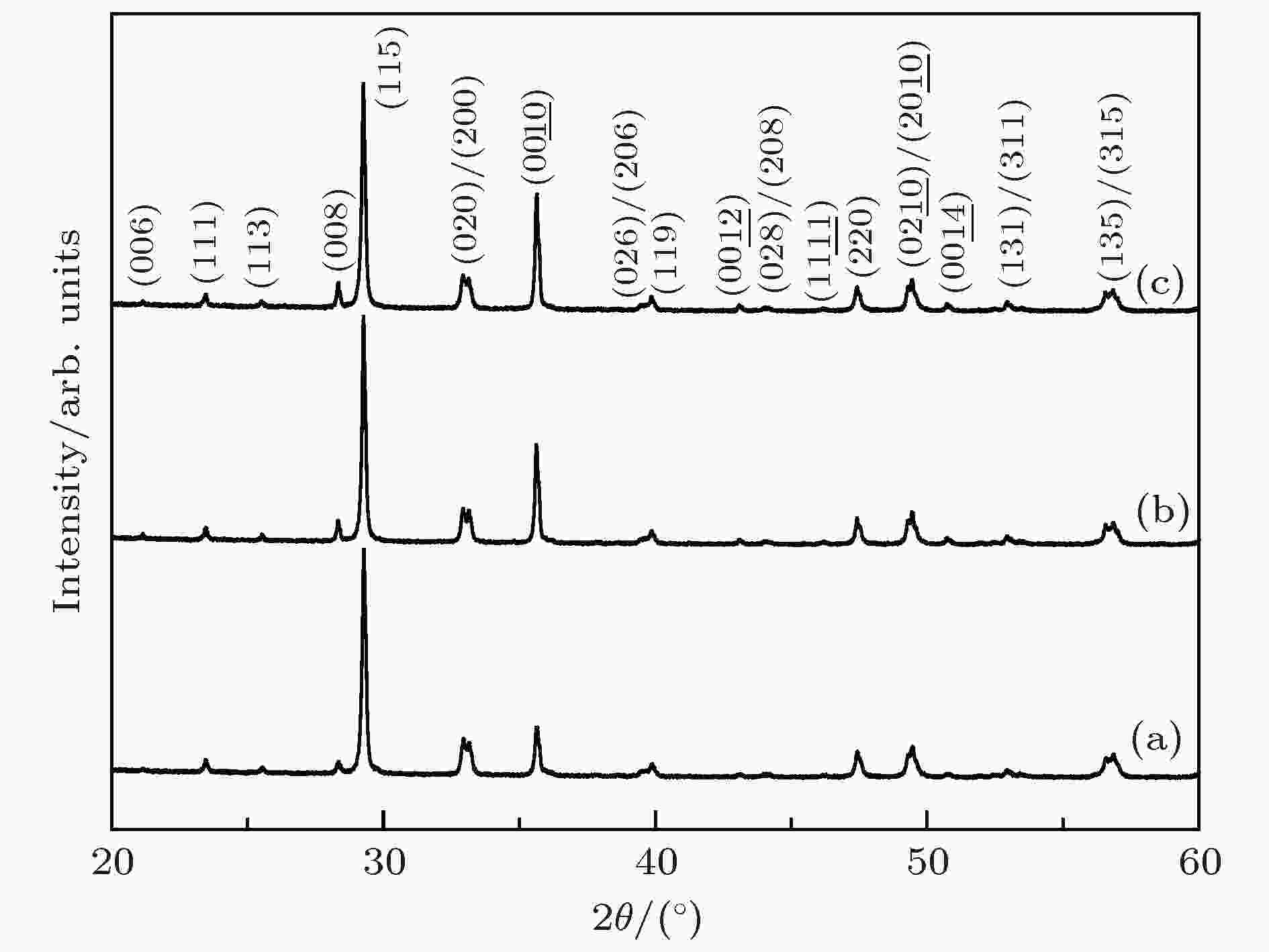 图 2 Bi3TiTaO9压电陶瓷的粉末XRD图谱 (a) x = 0; (b) x = 0.4; (c) x = 0.8
图 2 Bi3TiTaO9压电陶瓷的粉末XRD图谱 (a) x = 0; (b) x = 0.4; (c) x = 0.8Figure2. Powder X-ray diffraction of Bi3TiTaO9 ceramics: (a) x = 0; (b) x = 0.4; (c) x = 0.8
图3为Bi3TiTaO9陶瓷的压电系数d33随稀土Ce离子含量x的变化图谱. 从图中可以看出纯的BTT陶瓷的压电系数d33值只有4.2 pC/N, 其压电性能约为放电等离子烧结技术制备的织构化Bi3TiTaO9陶瓷的压电性能 (~8.6 pC/N)的一半[17]. 随着Ce离子含量的增加, 压电系数d33值得到显著提高, 在x = 0.6处压电系数d33值达到峰值后缓慢下降. 在Ce含量为0.6 wt.%时, 即x = 0.6组分处, BTT-6Ce (x = 0.6)陶瓷具有最高的压电系数d33值(d33~16.2 pC/N), 约为纯的BTT陶瓷压电系数d33的4倍. BTT-6Ce (x = 0.6)的压电性能已超过商用的铋层状结构钛酸盐基高温压电陶瓷(TC > 800 ℃)的性能(d33~12 pC/N)[1].
图4为压电性能最优的组分BTT-6Ce (x = 0.6)陶瓷平面振动模式的阻抗和相角频谱. 阻抗最低值和最高值对应的频率分别为谐振频率(fr)和反谐振频率(fa). 对于理想的压电体, 在谐振频率和反谐振频率之间的频段, 阻抗相角θ接近于90°. 图4显示BTT-6Ce (x = 0.6)陶瓷的阻抗相角在谐振频率和反谐振频率之间频段接近90°, 这说明BTT-6Ce (x = 0.6)陶瓷得到了充分极化.
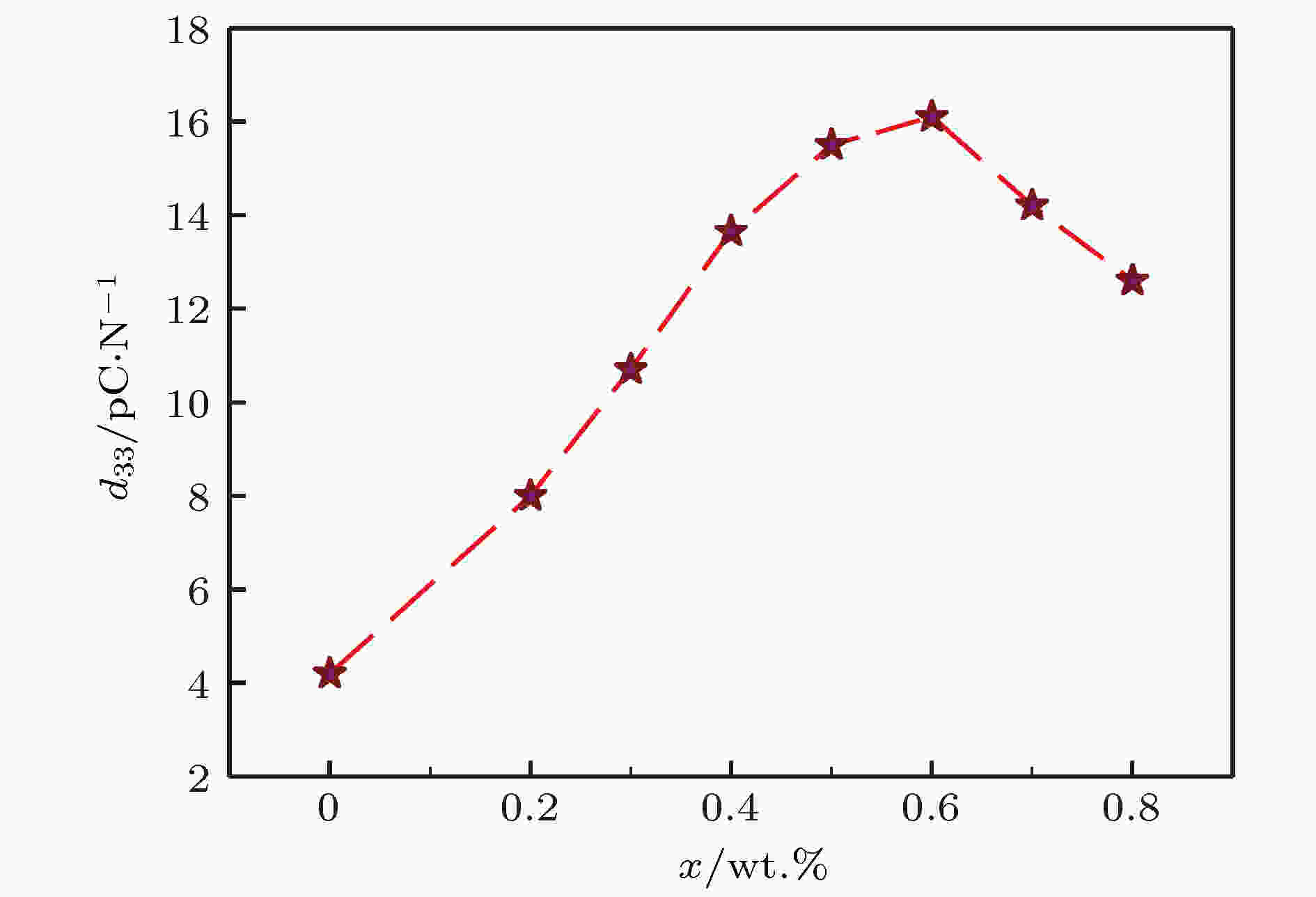 图 3 压电系数d33随x的变化图谱
图 3 压电系数d33随x的变化图谱Figure3. Composition-dependent piezoelectric coefficient d33
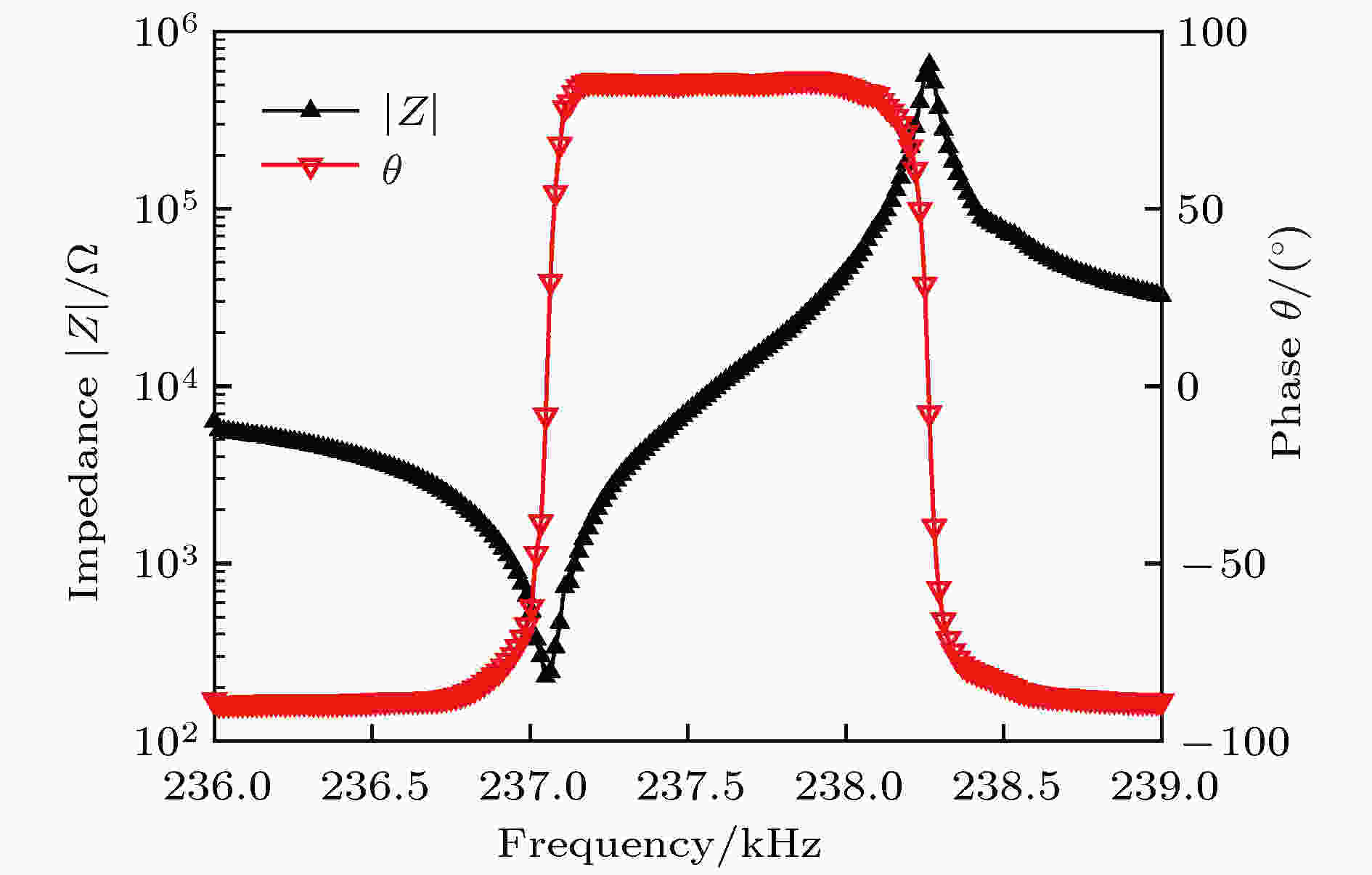 图 4 阻抗|Z|和相角θ频谱
图 4 阻抗|Z|和相角θ频谱Figure4. Frequency dependence of impedance |Z| and phase angle θ of BTT-6Ce in planar mode
图5为Bi3TiTaO9陶瓷的扫描电镜(SEM)图, 其中图5 (a)为纯的BTT陶瓷表面SEM图像, 图5 (b)为x = 0.6的稀土Ce离子掺杂的BTT陶瓷表面SEM图像. 从图中可以看出, 晶粒呈现出明显的各向异性, 晶粒形貌成片(盘)状, 这是典型的铋层状结构压电陶瓷的微观形貌特征. 晶粒的各向异性生长是因为沿a-b面方向的生长速率远远大于沿c轴方向的生长速率. 从图中还可以看出, Ce掺杂的BTT陶瓷晶粒尺寸明显增大, 这说明Ce对Bi的取代显著促进了BTT陶瓷晶粒的生长. 由于各种方位取向的片状晶粒堆积在一起, 我们从SEM图像上难以定量地给出晶粒尺寸的分布情况.
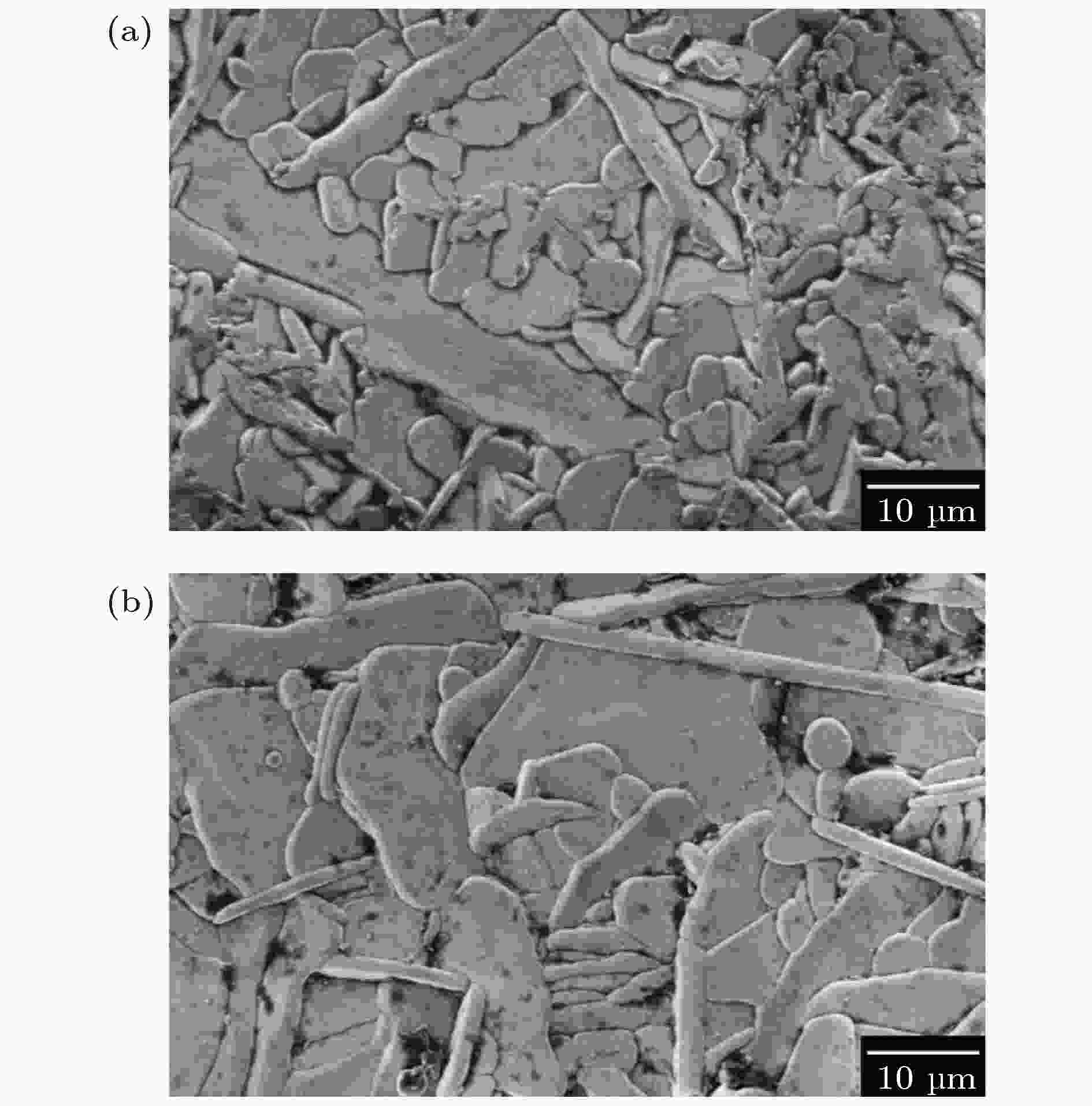 图 5 Bi3TiTaO9陶瓷表面扫描电镜 (a) x = 0; (b) x = 0.6
图 5 Bi3TiTaO9陶瓷表面扫描电镜 (a) x = 0; (b) x = 0.6Figure5. Scanning electron microscopy images showing the surfaces of Bi3TiTaO9 ceramics: (a) x = 0; (b) x = 0.6
图6(a)和图6(b)分别为纯的Bi3TiTaO9陶瓷和压电性能最优的BTT-6Ce (x = 0.6)陶瓷在频率为1 MHz时的介电常数和介电损耗tanδ随温度的变化曲线图. 随着温度的增加, 样品的介电常数和介电损耗也逐渐增加. 介电频谱的峰值对应温度为铁电-顺电的相变温度, 即居里温度TC, 如图6(a)内插图所示. 纯的BTT陶瓷的居里温度TC为890 ℃, 这与文献报道的纯的BTT的居里温度为890 ℃相一致. BTT-6Ce (x = 0.6)陶瓷的居里温度TC为879 ℃, 表明Ce离子对Bi的取代降低了BTT的居里温度, 但仍接近于900 ℃. 前人研究报道铋层状结构化合物的居里温度随着类钙钛矿层中A位离子半径的减小而升高[25]. 在这里, Ce取代BTT类钙钛矿层中A位Bi离子,12配位的XIICe+3和XIIBi+3的离子半径均为134 pm. 因取代量较少, 而且XIICe+3和XIIBi+3的离子半径非常接近, 故Ce取代后的BTT陶瓷的居里温度变化很小, 但本实验显示Ce的引入降低了BTT陶瓷的居里温度. 图6(b)的介电损耗温谱显示Ce的引入显著降低了BTT陶瓷高温下的的介电损耗tanδ, 特别是400—600 ℃温度区间的介电损耗. 在室温至400 ℃的温度区间内, BTT陶瓷的介电损耗tanδ在0.02以下, 当温度超过400 ℃时, 介电损耗急遽增加, 如图6(b)内插图所示. 而BTT-6Ce (x = 0.6)陶瓷的高温介电损耗, 在室温至600 ℃的温度区间内, 仍在0.02以下, 这表明稀土Ce离子的引入极大地降低了BTT陶瓷的介电损耗. 在前人的研究中发现, 稀土Ce离子引入钙钛矿结构PZT压电陶瓷有许多优点, 能够降低介电损耗, 提高压电性能[26]. 这与本实验Ce离子取代BTT的A位Bi离子, 引起BTT陶瓷介电损耗降低、压电性能提高的结果是一致的. 但是, 对于Ce离子引入的作用机理, 目前尚未有明确的结论[26].
 图 6 Bi3TiTaO9陶瓷的介电温谱 (a) 介电常数; (b) 介电损耗 (1 MHz)
图 6 Bi3TiTaO9陶瓷的介电温谱 (a) 介电常数; (b) 介电损耗 (1 MHz)Figure6. Temperature dependence of the dielectric constant (a), dielectric loss tanδ for the Bi3TiTaO9 ceramics measured at 1 MHz (b)
图7(a)和图7(b)分别为纯的BTT和BTT-6Ce (x = 0.6)陶瓷在电场为90 kV/cm, 频率为1 Hz时的室温电滞回线(P-E)图以及电流(I-E)图. 在90 kV/cm的电场驱动下, P-E回线几乎为线性, 而且没有极化电流出现; 当驱动电场超过100 kV/cm时, 样品容易被击穿. 图7 I-E图显示, BTT和BTT-6Ce (x = 0.6)陶瓷在90 kV/cm的电场驱动下未出现极化反转电流, 这说明BTT和BTT-6Ce (x = 0.6)陶瓷的室温矫顽场Ec可能高于驱动电场, 导致样品直至击穿也未得到饱和的电滞回线. 同时这种现象与BTT压电陶瓷在室温极化时, 即使样品被击穿也无法得到理想的压电性能是一致的. 因此, 在180 ℃ (样品的极化温度)对BTT压电陶瓷进行了测试. 电滞回线测试结果显示样品在180 ℃可以承受更高的电场. 图8(a)和图8(b)分别为纯的BTT和BTT-6Ce (x = 0.6)陶瓷在电场为110 kV/cm, 频率为1 Hz, 温度为180 ℃时的P-E图以及I-E图. 纯的BTT压电陶瓷的矫顽场Ec = 53.8 kV/cm, 剩余极化强度Pr = 3.4 μC/cm2, 最大极化强度Pmax = 5.8 μC/cm2. 图中也给出了BTT压电陶瓷电流强度I随驱动电场E的变化曲线图谱, 对应于在矫顽场Ec处, 电流I具有最大峰值(或最小值, 对应–Ec), 说明此处由于电畴的反转导致了电荷的快速传输, 极化电流峰越尖锐, 电滞回线显示也就越饱和. BTT-6Ce (x = 0.6)陶瓷的矫顽场Ec = 57.5 kV/cm, 剩余极化强度Pr = 5.4 μC/cm2, 最大极化强度Pmax = 8.0 μC/cm2. 与纯的BTT陶瓷相比较, BTT-6Ce (x = 0.6)陶瓷的剩余极化强度Pr和最大极化强度Pmax显著提高. 高的极化强度往往伴随着强的压电性能[27], 因此, BTT-6Ce (x = 0.6)陶瓷具有强的压电性能与其具有高的极化强度是一致的.
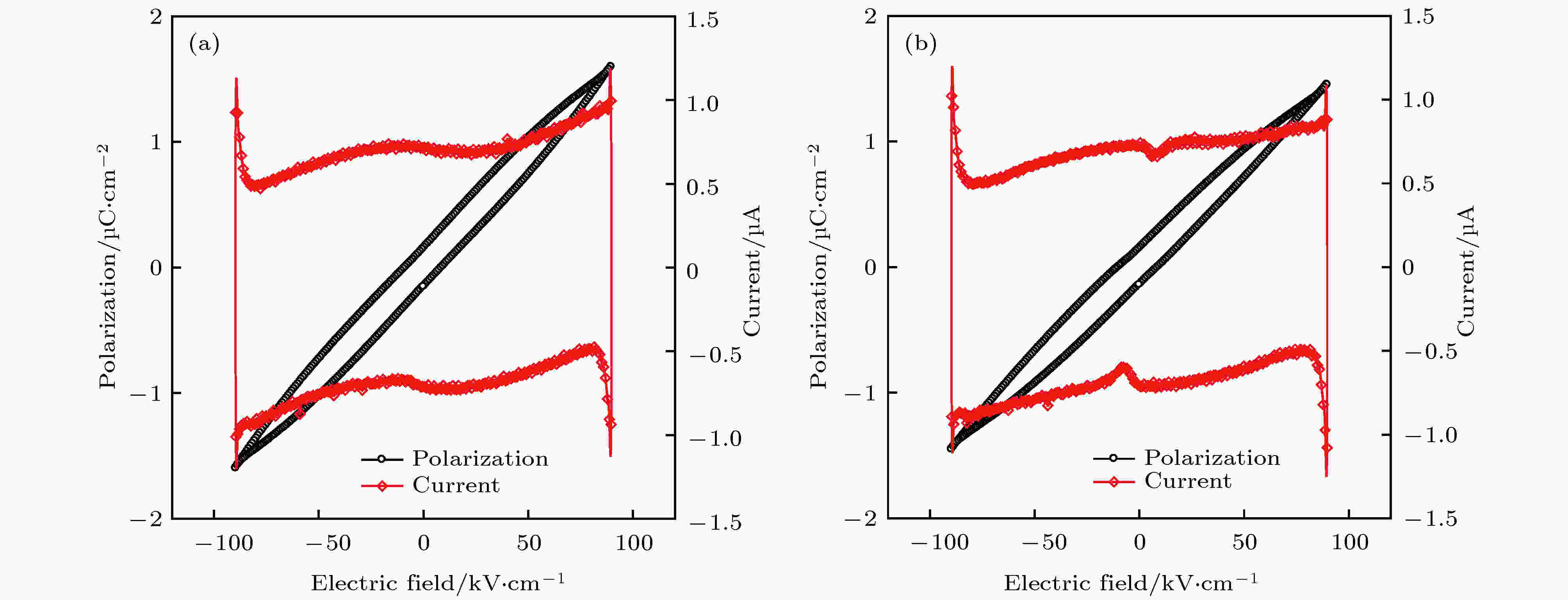 图 7 (a) BTT和(b) BTT-6Ce (x = 0.6)陶瓷的室温P-E和I-E图谱(频率1 Hz)
图 7 (a) BTT和(b) BTT-6Ce (x = 0.6)陶瓷的室温P-E和I-E图谱(频率1 Hz)Figure7. The polarization-electric field hysteresis (P-E) loops and current-electric field (I-E) curves of BTT (a), and BTT-6Ce (x = 0.6) (b) ceramics measured at room temperature and at a frequency of 1 Hz
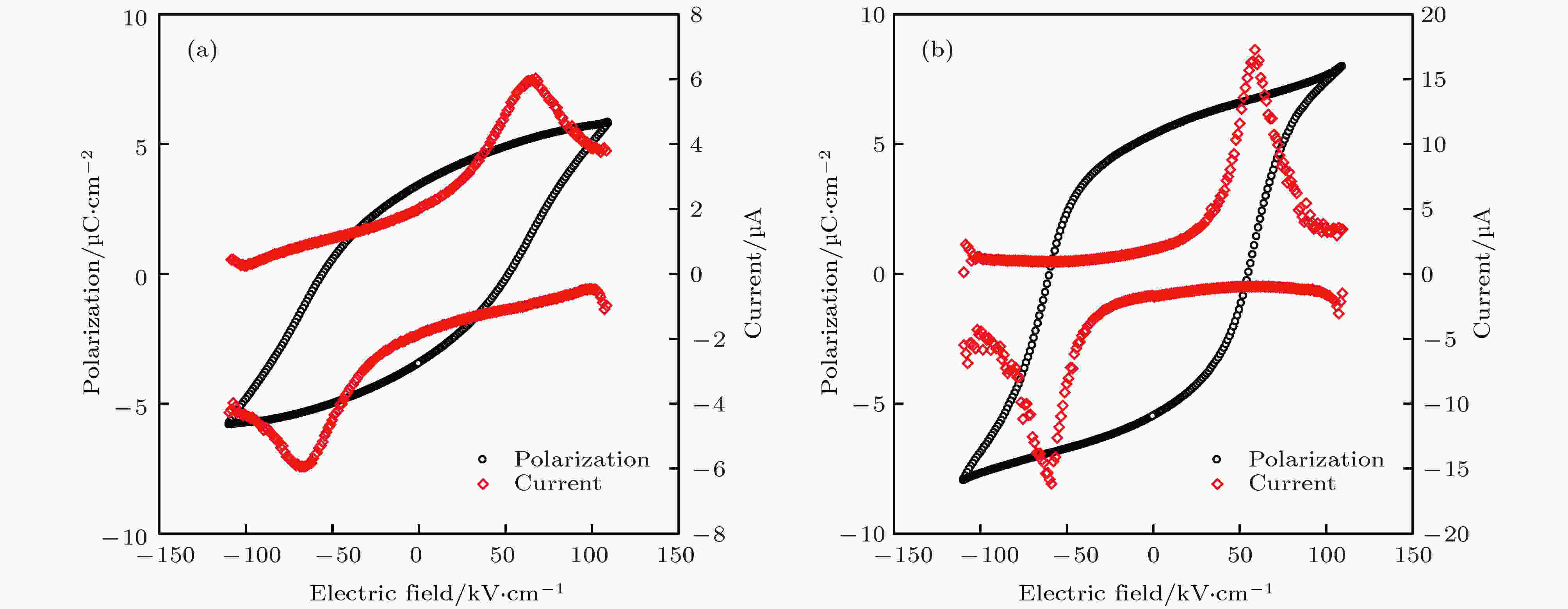 图 8 (a) BTT和 (b) BTT-6Ce (x = 0.6) 陶瓷的P-E和I-E图谱 (180 ℃, 频率1 Hz)
图 8 (a) BTT和 (b) BTT-6Ce (x = 0.6) 陶瓷的P-E和I-E图谱 (180 ℃, 频率1 Hz)Figure8. The polarization-electric field hysteresis (P-E) loops and current-electric field (I-E) curves of BTT (a) and BTT-6Ce (x = 0.6) (b) ceramics measured at 180 ℃ and at a frequency of 1 Hz
表1总结了高居里温度(TC~900 ℃) m = 2的铋层状结构氧化物压电陶瓷的电学性能参数(居里温度TC和压电性能d33). 从表中可以看出, 居里温度TC在900 ℃左右的原型铋层状结构压电陶瓷的压电系数d33一般不高于5 pC/N, 组分优化后的压电陶瓷的压电系数d33可达16 pC/N, 是原型铋层状结构压电陶瓷压电性能的3—5倍. 纯的BTT陶瓷的压电系数d33为4.2 pC/N, 经稀土Ce离子优化后, BTT-Ce陶瓷压电性能大幅提高. BTT-6Ce (x = 0.6)陶瓷压电系数d33为16.2 pC/N, 约为BTT陶瓷压电性能的4倍. 稀土Ce离子掺杂的BTT压电性能的提高可归因于BTT-6Ce具有更高的极化强度和较低的介电损耗.
| m | Ceramics | TC/℃ | d33/pC·N–1 | Ref. |
| 2 | CBN | 936 | 5 | [9] |
| 2 | BTN | 907 | 3 | [10] |
| 2 | BTT | 890 | 4.2 | This work |
| 2 | CBN-NaCe | 900 | 16 | [28] |
| 2 | BTN-Ce | 894 | 16 | [29] |
| 2 | BTT-Ce | 879 | 16.2 | This work |
表1高居里温度(TC~900 ℃)铋层状结构氧化物压电陶瓷的电学性能参数: CaBi2Nb2O9 (CBN), Bi3TiNbO9 (BTN), Bi3TiTaO9 (BTT)
Table1.Electrical parameters of high Curie temperature (TC~900 ℃) bismuth layer-structured oxide piezoelectric ceramics: CaBi2Nb2O9 (CBN), Bi3TiNbO9 (BTN), Bi3TiTaO9 (BTT)
图9为BTT和稀土Ce离子掺杂的BTT陶瓷的压电系数d33值随退火温度的变化趋势图. 压电系数d33值是在退火温度下保温2 h后在室温测得. 从图中可以看出, 即使经800 ℃的退火处理, BTT和BTT-Ce陶瓷的压电系数d33值仍没有明显的下降, 这显示了800 ℃的高温退火对铋层状结构BTT陶瓷的压电性能影响较小. 当退火温度接近900 ℃, 压电系数d33值开始急速下降并趋于零. 压电系数d33值随退火温度的变化趋势图表明稀土Ce离子掺杂的BTT陶瓷不仅具有强的压电性能和高的居里温度, 而且经800 ℃的高温退火, 仍然具有较好的压电性能温度稳定性. 铋层状结构钽酸盐钛钽酸铋(Bi3TiTaO9)是一类可以在居里温度和压电性能方面与铋层状结构铌酸盐媲美的压电陶瓷.
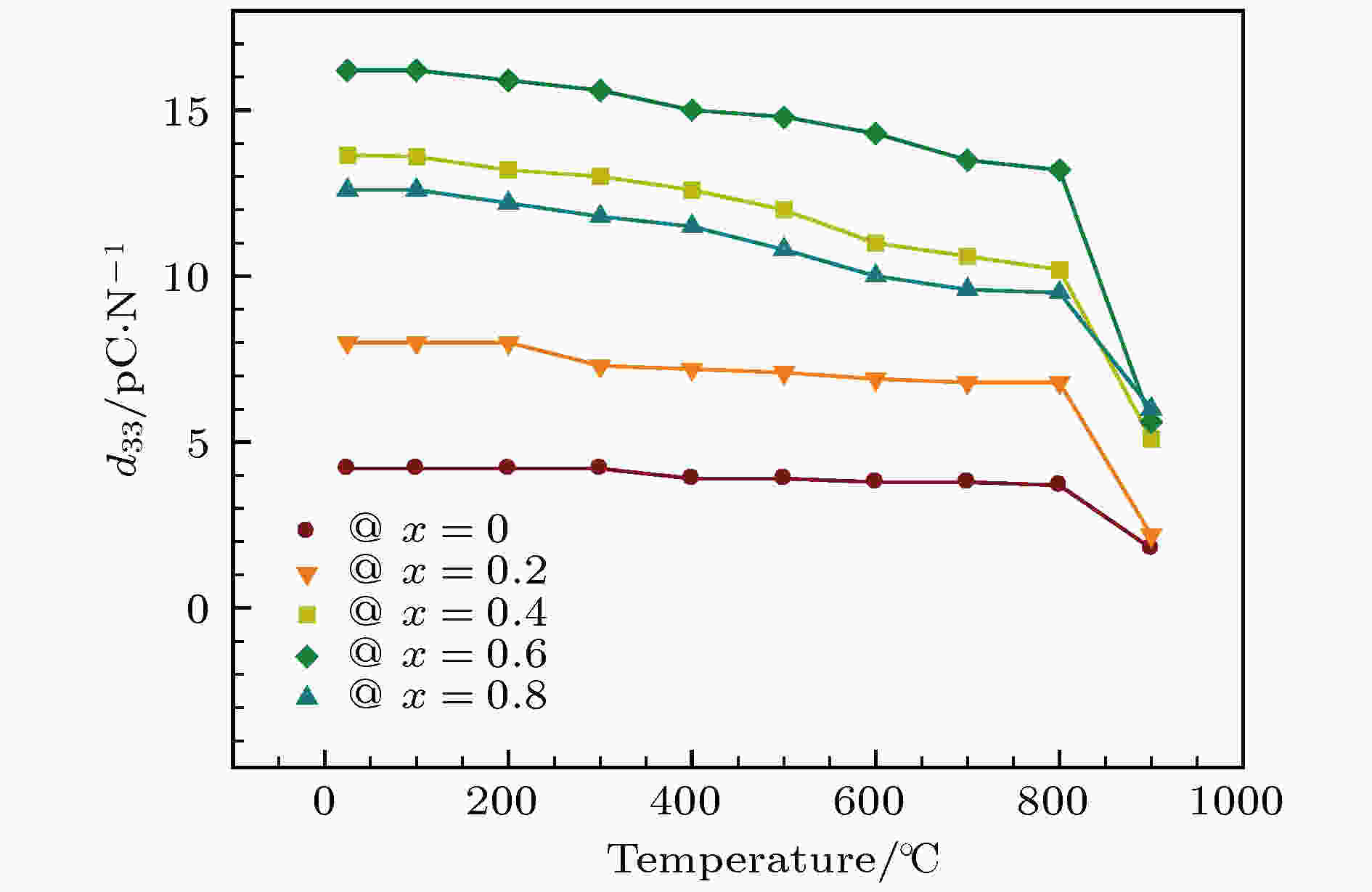 图 9 退火温度对BTT陶瓷压电系数d33的影响
图 9 退火温度对BTT陶瓷压电系数d33的影响Figure9. The piezoelectric coefficient d33 of the BTT and BTT-Ce ceramics as a function of annealing temperature
